Christian A. Naesseth
Equivariant Neural Diffusion for Molecule Generation
Jun 12, 2025Abstract:We introduce Equivariant Neural Diffusion (END), a novel diffusion model for molecule generation in 3D that is equivariant to Euclidean transformations. Compared to current state-of-the-art equivariant diffusion models, the key innovation in END lies in its learnable forward process for enhanced generative modelling. Rather than pre-specified, the forward process is parameterized through a time- and data-dependent transformation that is equivariant to rigid transformations. Through a series of experiments on standard molecule generation benchmarks, we demonstrate the competitive performance of END compared to several strong baselines for both unconditional and conditional generation.
SDE Matching: Scalable and Simulation-Free Training of Latent Stochastic Differential Equations
Feb 04, 2025Abstract:The Latent Stochastic Differential Equation (SDE) is a powerful tool for time series and sequence modeling. However, training Latent SDEs typically relies on adjoint sensitivity methods, which depend on simulation and backpropagation through approximate SDE solutions, which limit scalability. In this work, we propose SDE Matching, a new simulation-free method for training Latent SDEs. Inspired by modern Score- and Flow Matching algorithms for learning generative dynamics, we extend these ideas to the domain of stochastic dynamics for time series and sequence modeling, eliminating the need for costly numerical simulations. Our results demonstrate that SDE Matching achieves performance comparable to adjoint sensitivity methods while drastically reducing computational complexity.
Variational Pseudo Marginal Methods for Jet Reconstruction in Particle Physics
Jun 05, 2024



Abstract:Reconstructing jets, which provide vital insights into the properties and histories of subatomic particles produced in high-energy collisions, is a main problem in data analyses in collider physics. This intricate task deals with estimating the latent structure of a jet (binary tree) and involves parameters such as particle energy, momentum, and types. While Bayesian methods offer a natural approach for handling uncertainty and leveraging prior knowledge, they face significant challenges due to the super-exponential growth of potential jet topologies as the number of observed particles increases. To address this, we introduce a Combinatorial Sequential Monte Carlo approach for inferring jet latent structures. As a second contribution, we leverage the resulting estimator to develop a variational inference algorithm for parameter learning. Building on this, we introduce a variational family using a pseudo-marginal framework for a fully Bayesian treatment of all variables, unifying the generative model with the inference process. We illustrate our method's effectiveness through experiments using data generated with a collider physics generative model, highlighting superior speed and accuracy across a range of tasks.
Fast yet Safe: Early-Exiting with Risk Control
May 31, 2024



Abstract:Scaling machine learning models significantly improves their performance. However, such gains come at the cost of inference being slow and resource-intensive. Early-exit neural networks (EENNs) offer a promising solution: they accelerate inference by allowing intermediate layers to exit and produce a prediction early. Yet a fundamental issue with EENNs is how to determine when to exit without severely degrading performance. In other words, when is it 'safe' for an EENN to go 'fast'? To address this issue, we investigate how to adapt frameworks of risk control to EENNs. Risk control offers a distribution-free, post-hoc solution that tunes the EENN's exiting mechanism so that exits only occur when the output is of sufficient quality. We empirically validate our insights on a range of vision and language tasks, demonstrating that risk control can produce substantial computational savings, all the while preserving user-specified performance goals.
Neural Flow Diffusion Models: Learnable Forward Process for Improved Diffusion Modelling
Apr 19, 2024Abstract:Conventional diffusion models typically relies on a fixed forward process, which implicitly defines complex marginal distributions over latent variables. This can often complicate the reverse process' task in learning generative trajectories, and results in costly inference for diffusion models. To address these limitations, we introduce Neural Flow Diffusion Models (NFDM), a novel framework that enhances diffusion models by supporting a broader range of forward processes beyond the fixed linear Gaussian. We also propose a novel parameterization technique for learning the forward process. Our framework provides an end-to-end, simulation-free optimization objective, effectively minimizing a variational upper bound on the negative log-likelihood. Experimental results demonstrate NFDM's strong performance, evidenced by state-of-the-art likelihood estimation. Furthermore, we investigate NFDM's capacity for learning generative dynamics with specific characteristics, such as deterministic straight lines trajectories. This exploration underscores NFDM's versatility and its potential for a wide range of applications.
VISA: Variational Inference with Sequential Sample-Average Approximations
Mar 15, 2024



Abstract:We present variational inference with sequential sample-average approximation (VISA), a method for approximate inference in computationally intensive models, such as those based on numerical simulations. VISA extends importance-weighted forward-KL variational inference by employing a sequence of sample-average approximations, which are considered valid inside a trust region. This makes it possible to reuse model evaluations across multiple gradient steps, thereby reducing computational cost. We perform experiments on high-dimensional Gaussians, Lotka-Volterra dynamics, and a Pickover attractor, which demonstrate that VISA can achieve comparable approximation accuracy to standard importance-weighted forward-KL variational inference with computational savings of a factor two or more for conservatively chosen learning rates.
Neural Diffusion Models
Oct 12, 2023Abstract:Diffusion models have shown remarkable performance on many generative tasks. Despite recent success, most diffusion models are restricted in that they only allow linear transformation of the data distribution. In contrast, broader family of transformations can potentially help train generative distributions more efficiently, simplifying the reverse process and closing the gap between the true negative log-likelihood and the variational approximation. In this paper, we present Neural Diffusion Models (NDMs), a generalization of conventional diffusion models that enables defining and learning time-dependent non-linear transformations of data. We show how to optimise NDMs using a variational bound in a simulation-free setting. Moreover, we derive a time-continuous formulation of NDMs, which allows fast and reliable inference using off-the-shelf numerical ODE and SDE solvers. Finally, we demonstrate the utility of NDMs with learnable transformations through experiments on standard image generation benchmarks, including CIFAR-10, downsampled versions of ImageNet and CelebA-HQ. NDMs outperform conventional diffusion models in terms of likelihood and produce high-quality samples.
Practical and Asymptotically Exact Conditional Sampling in Diffusion Models
Jun 30, 2023Abstract:Diffusion models have been successful on a range of conditional generation tasks including molecular design and text-to-image generation. However, these achievements have primarily depended on task-specific conditional training or error-prone heuristic approximations. Ideally, a conditional generation method should provide exact samples for a broad range of conditional distributions without requiring task-specific training. To this end, we introduce the Twisted Diffusion Sampler, or TDS. TDS is a sequential Monte Carlo (SMC) algorithm that targets the conditional distributions of diffusion models. The main idea is to use twisting, an SMC technique that enjoys good computational efficiency, to incorporate heuristic approximations without compromising asymptotic exactness. We first find in simulation and on MNIST image inpainting and class-conditional generation tasks that TDS provides a computational statistical trade-off, yielding more accurate approximations with many particles but with empirical improvements over heuristics with as few as two particles. We then turn to motif-scaffolding, a core task in protein design, using a TDS extension to Riemannian diffusion models. On benchmark test cases, TDS allows flexible conditioning criteria and often outperforms the state of the art.
E-Valuating Classifier Two-Sample Tests
Oct 24, 2022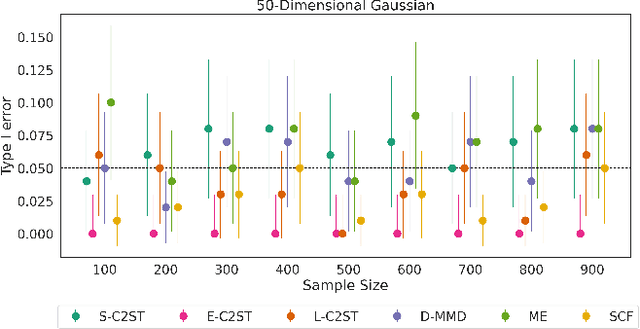
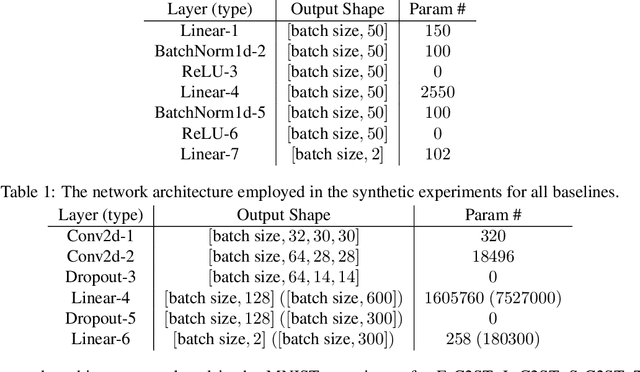
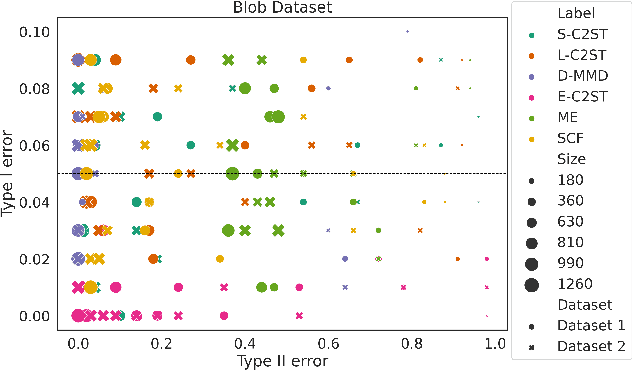
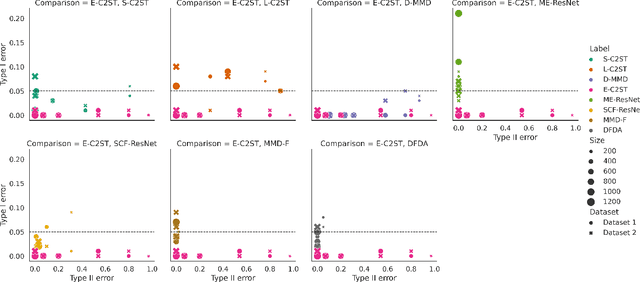
Abstract:We propose E-C2ST, a classifier two-sample test for high-dimensional data based on E-values. Compared to $p$-values-based tests, tests with E-values have finite sample guarantees for the type I error. E-C2ST combines ideas from existing work on split likelihood ratio tests and predictive independence testing. The resulting E-values incorporate information about the alternative hypothesis. We demonstrate the utility of E-C2ST on simulated and real-life data. In all experiments, we observe that when going from small to large sample sizes, as expected, E-C2ST starts with lower power compared to other methods but eventually converges towards one. Simultaneously, E-C2ST's type I error stays substantially below the chosen significance level, which is not always the case for the baseline methods. Finally, we use an MRI dataset to demonstrate that multiplying E-values from multiple independently conducted studies leads to a combined E-value that retains the finite sample type I error guarantees while increasing the power.
A Variational Perspective on Generative Flow Networks
Oct 14, 2022
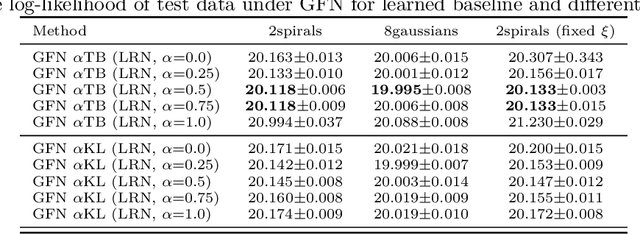


Abstract:Generative flow networks (GFNs) are a class of models for sequential sampling of composite objects, which approximate a target distribution that is defined in terms of an energy function or a reward. GFNs are typically trained using a flow matching or trajectory balance objective, which matches forward and backward transition models over trajectories. In this work, we define variational objectives for GFNs in terms of the Kullback-Leibler (KL) divergences between the forward and backward distribution. We show that variational inference in GFNs is equivalent to minimizing the trajectory balance objective when sampling trajectories from the forward model. We generalize this approach by optimizing a convex combination of the reverse- and forward KL divergence. This insight suggests variational inference methods can serve as a means to define a more general family of objectives for training generative flow networks, for example by incorporating control variates, which are commonly used in variational inference, to reduce the variance of the gradients of the trajectory balance objective. We evaluate our findings and the performance of the proposed variational objective numerically by comparing it to the trajectory balance objective on two synthetic tasks.
 Add to Chrome
Add to Chrome Add to Firefox
Add to Firefox Add to Edge
Add to Edge